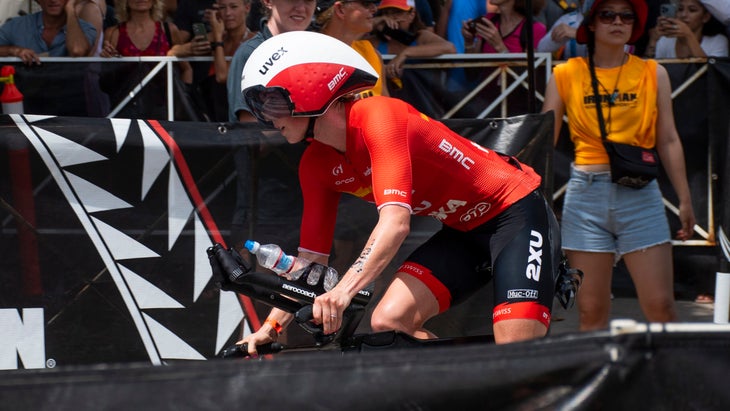New perk! Get after it with local recommendations just for you. Discover nearby events, routes out your door, and hidden gems when you sign up for the Local Running Drop.
Chelsea Sodaro rocked the triathlon world by not only becoming one of the rare rookies to win Kona on her first try (the last female to do so was the legendary Chrissie Wellington back in 2007), but also the first American in over a quarter of a century.
Though Sodaro is technically a rookie, it’s not exactly her first trip to the Big Island. Her coach, Dr. Dan Plews, is the age-group record holder (8:24, set in 2018), and therefore knows the course (and the conditions) inside and out. Firsthand, Sodaro has been to Kona five times before her victory, working with fellow pro Sarah Piampiano in her training blocks during the 2018 and 2019 seasons.
On his own record-setting day in Kona in 2018, Plews clocked a 2:50 run split and so set many of Sodaro’s run sessions based on what he knew it took him to do back then. Sodaro said: “A few weeks out from Kona when Dan told me he thought I could run between 2:50 to 2:55 I was almost insulted by that. I said to him, ‘Seriously, that’s it?’” But that was also when the experience of racing in the unforgiving heat and humidity of Hawaii helped Plews guide his charge more conservatively. “I know what it takes to run that kind of time in Kona. I looked at my data from when I was preparing for my race and that’s largely how I was able to predict her time so well.”
Below, we get a rare opportunity to look at some of the key sessions, based in part of Plews’ own record-setting data, that helped Sodaro lock in her huge win.
For more on Sodaro’s winding path to Ironman World Championship glory, take a look at our profile with behind-the-scenes insight from both Sodaro and her coach—everything from the PTO’s maternity leave program, to falling in love with the sport again, to her deepest moments of doubt.

How She Did It – Chelsea Sodaro Ironman World Champion, 2022
Swim: Pull Paddles
Total: ~5,000
Warm-up:
As needed
Main set:
10 x 400 with pull buoy and paddles
A central theme to Sodaro’s swim training was building strength endurance. She typically swam 20K a week across five sessions: one threshold, one technique, two endurance swims, and this strength endurance session above.
RELATED: Dear Coach: Why Should I Use Swim Paddles?
Bike: Strength Endurance
Total: 1h50m+
Warm-up:
15 minutes easy (or more, as needed)
Main set:
8 x (8 minutes just above Ironman power, 2 minutes recovery between, holding 60-65 RPM)
Cooldown:
As needed
Plews said: “A large part of this year was spent working on building Chelsea’s strength endurance on the bike. The slow cadence work is really important for triathletes, as so much comes down to strength endurance in Ironman racing, especially for smaller athletes like Chelsea who aren’t naturally that strong.”
RELATED: Riding with a Power Meter Will Supercharge Your Training
Run: Hilly Long-Run Tempo
Total: 15 miles
Warm-up:
3 miles build
Main set:
On an undulating route, run 9 miles at target Ironman race pace
Cooldown:
3 miles relaxed running
Plews said: “You want to do this run on a hilly route at target race pace, but due to the nature of the terrain your heart rate should be closer to anaerobic threshold or 70.3 heart rate. It’s a really good session because you have to run the downhills harder to keep your heart rate up, which is really good for conditioning the quads for the backend of the marathon.”
RELATED: What’s the Difference Between Aerobic and Anaerobic?

